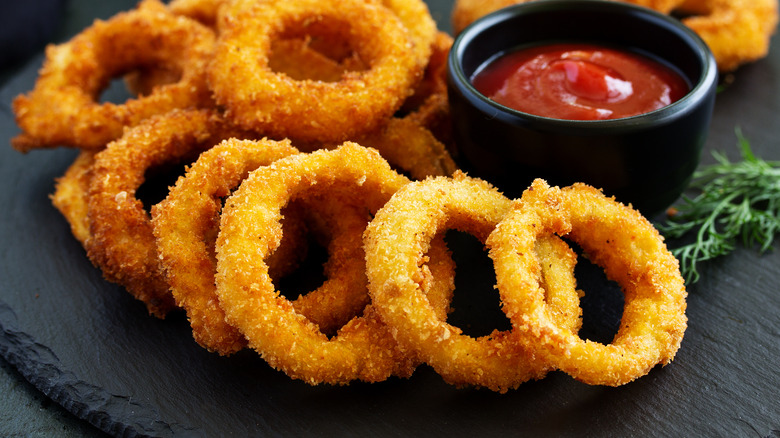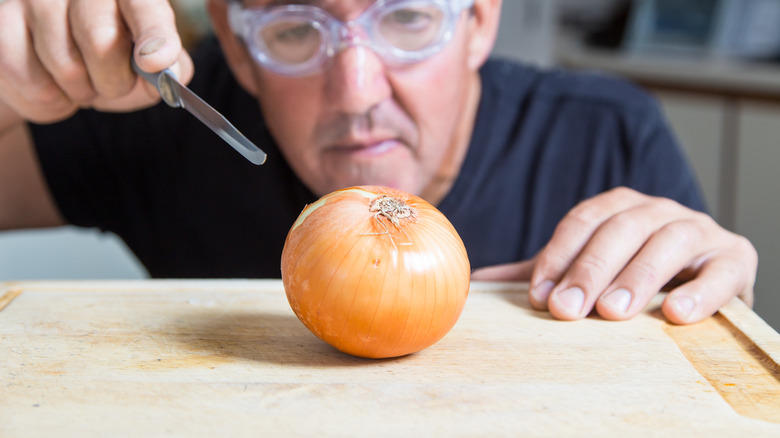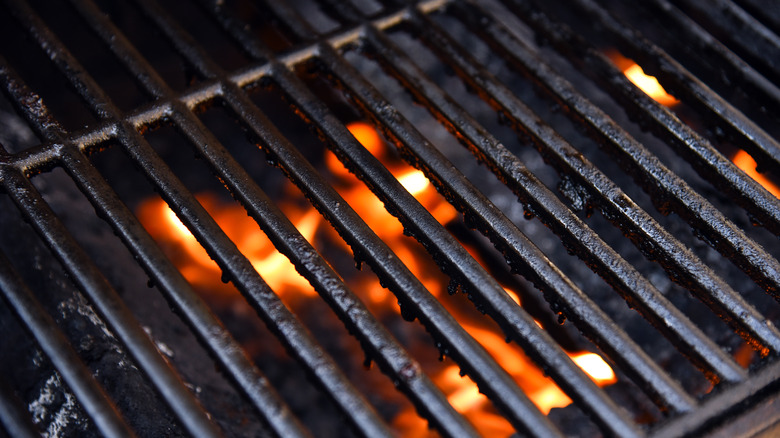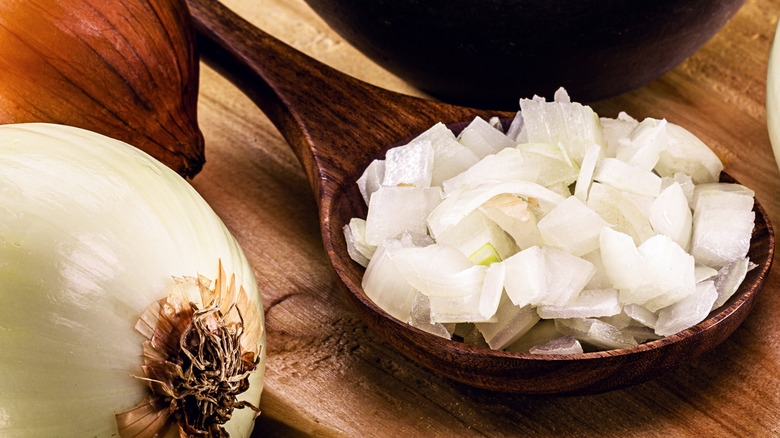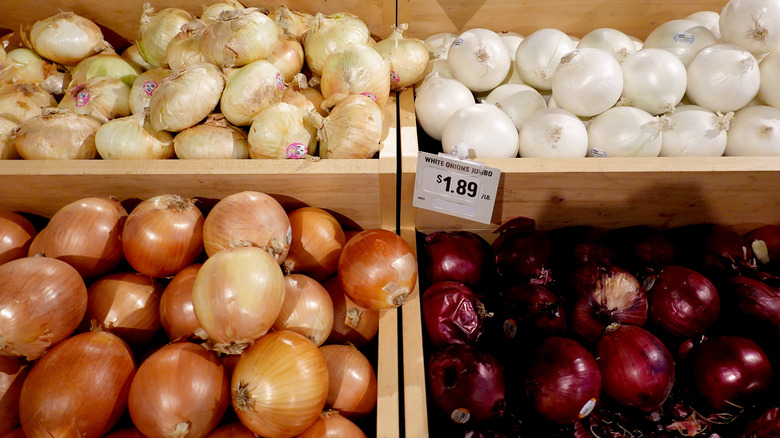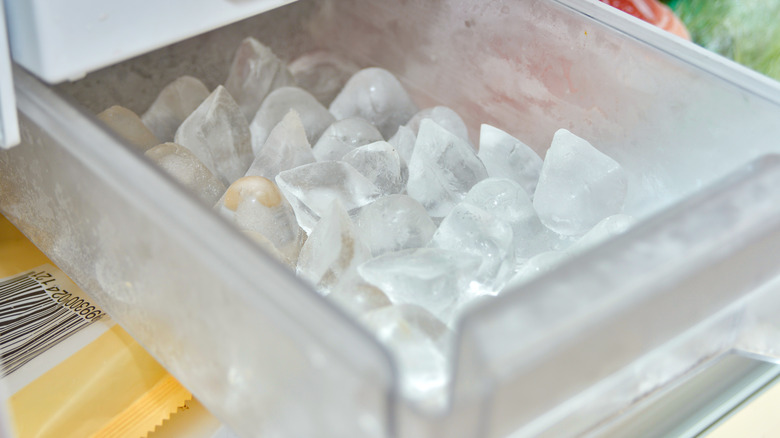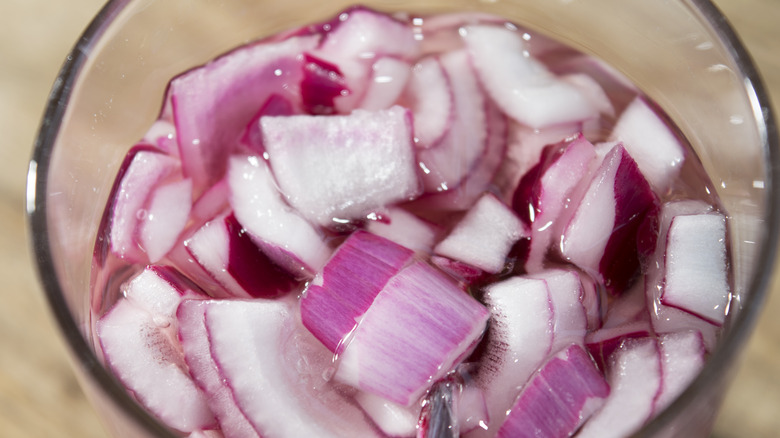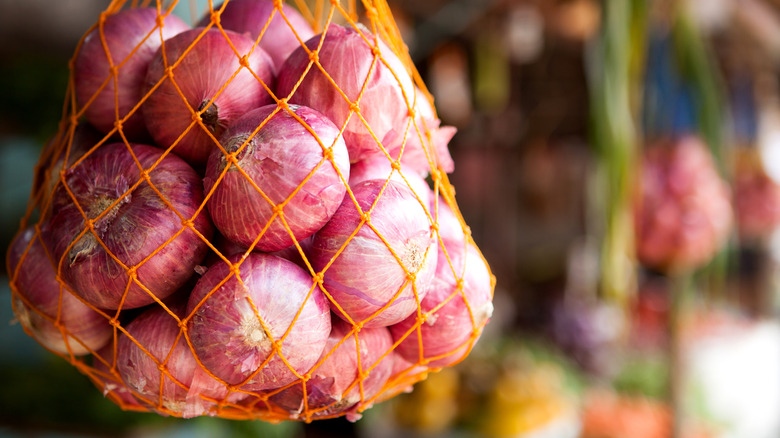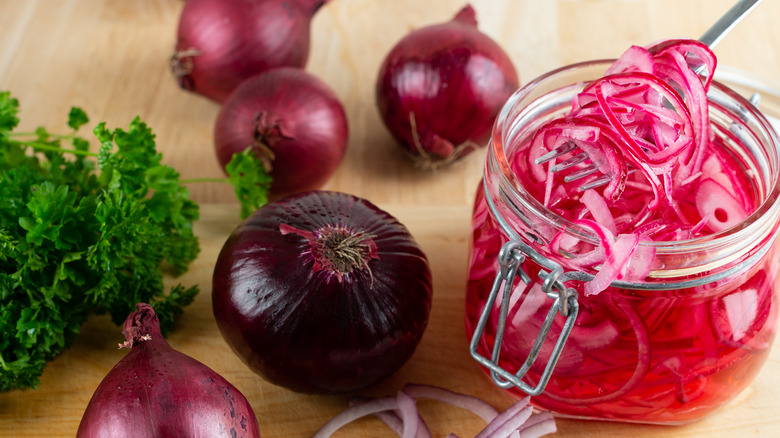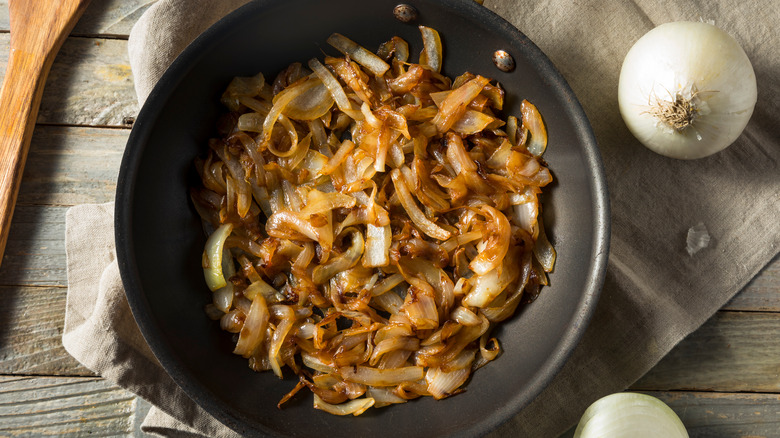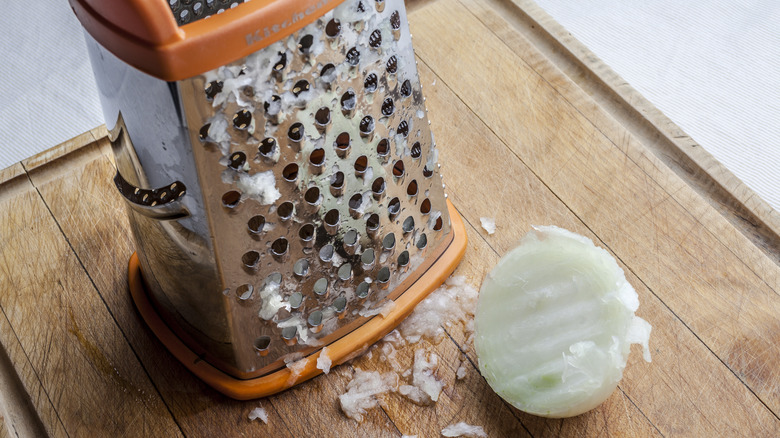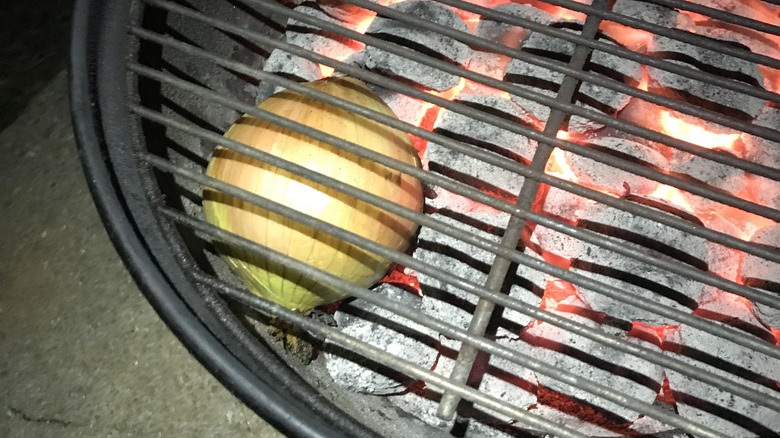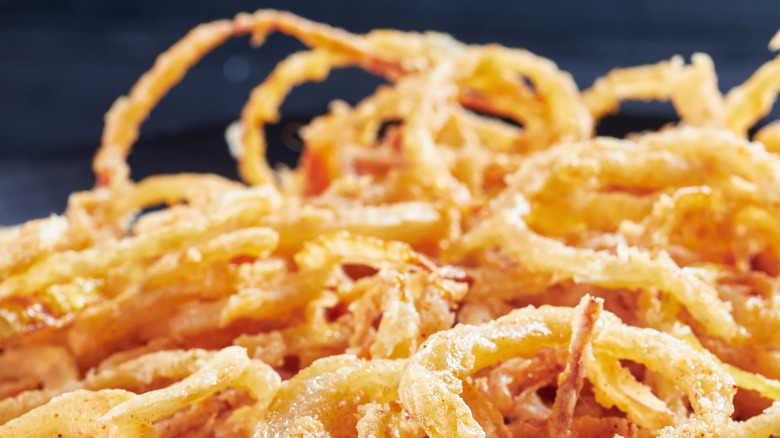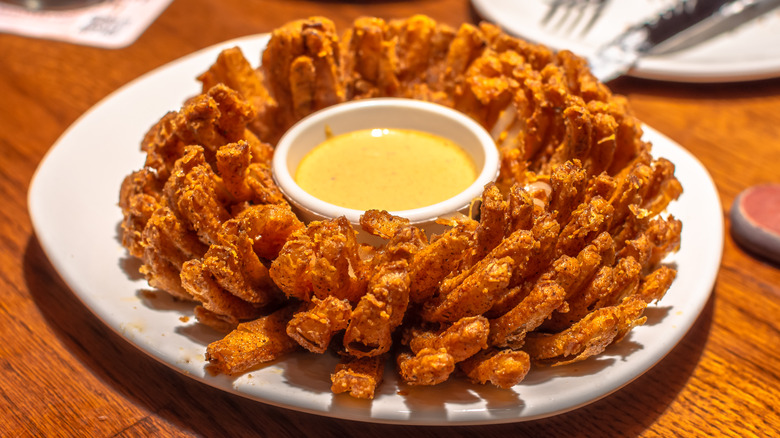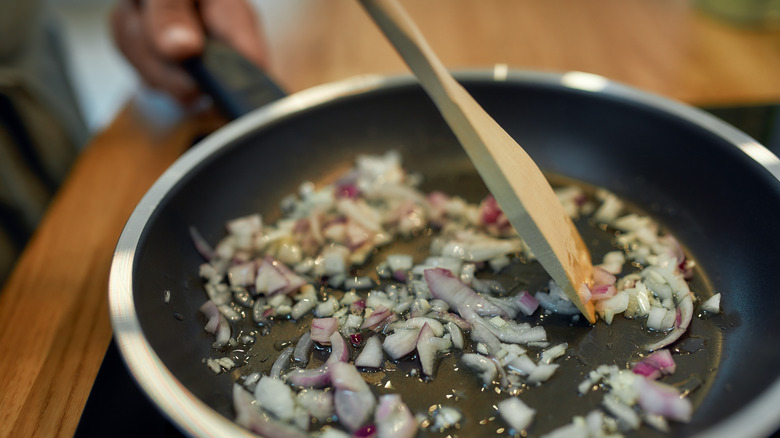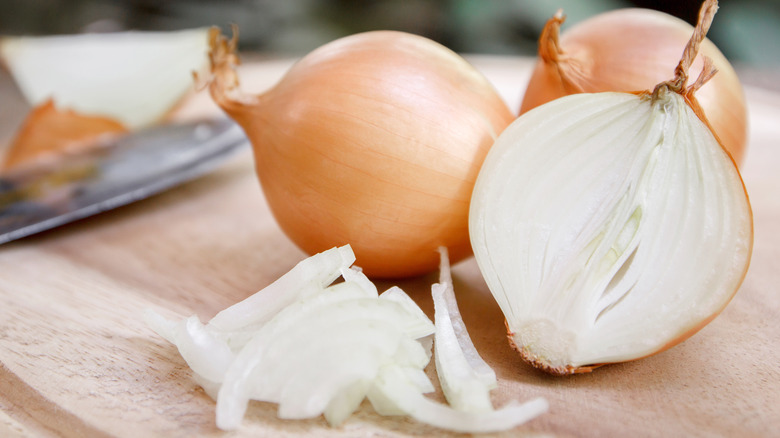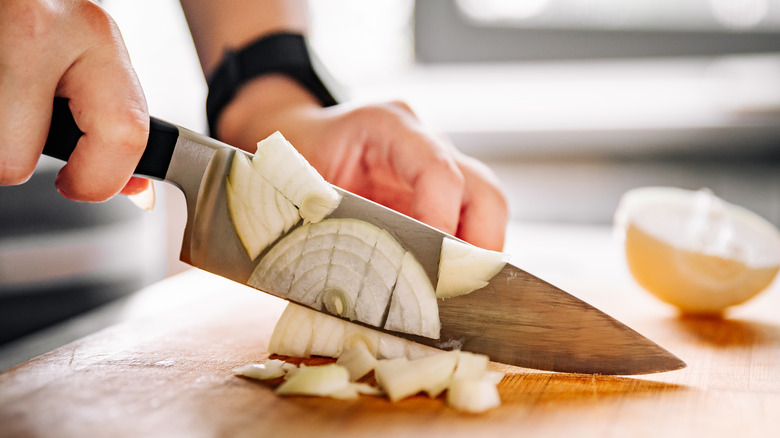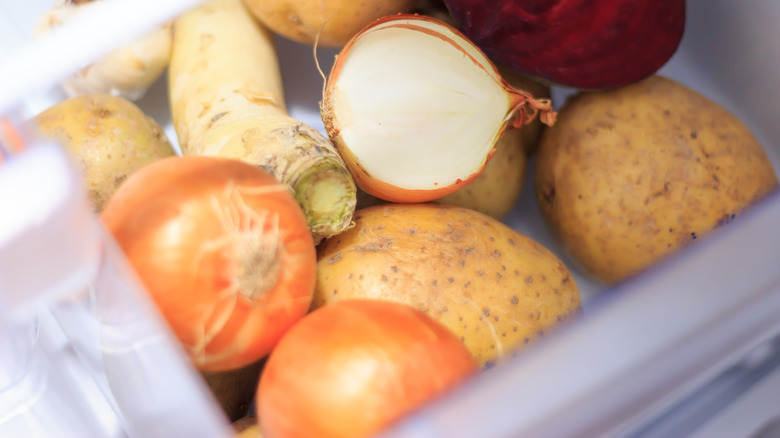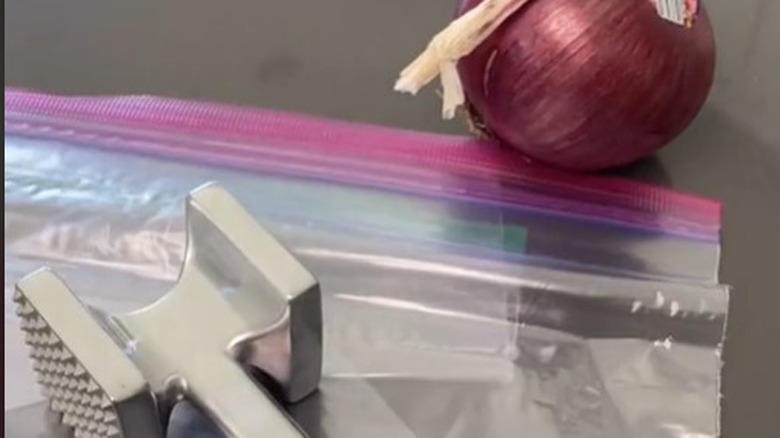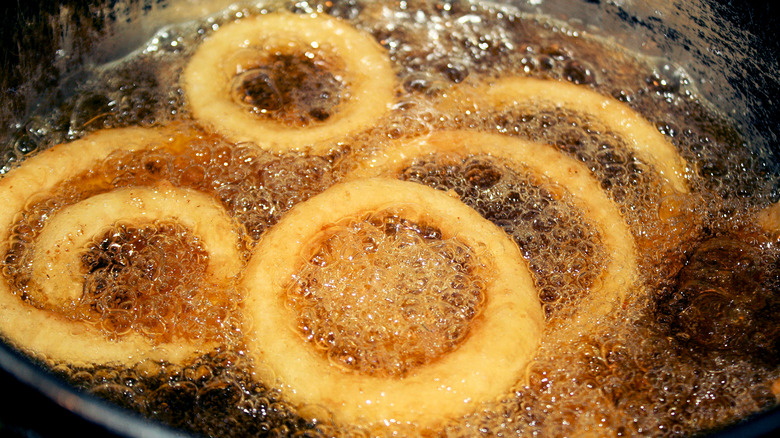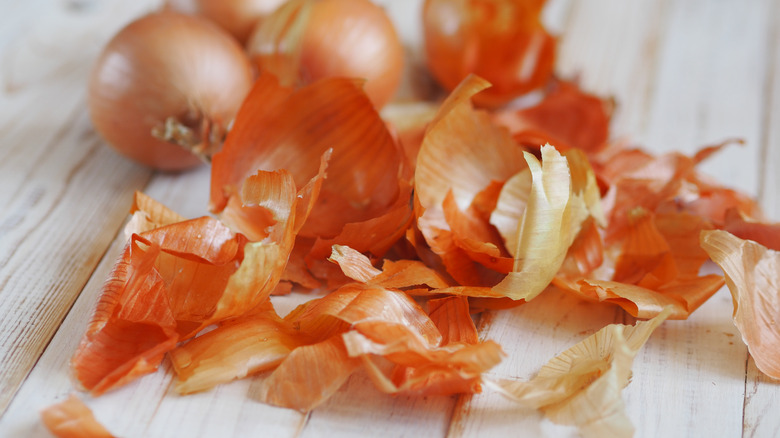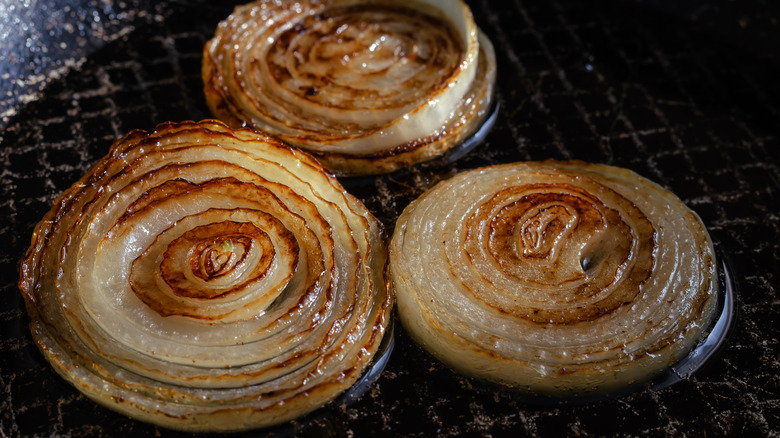25 Onion Hacks That Make Cooking Easier
"It's hard to imagine civilization without onions," once declared chef, author, and teacher Julia Child (via Keep Inspiring). While columnist Elizabeth Robins Pennell waxed lyrical about the necessity of onions in cooking: "Banish (the onion) from the kitchen and the pleasure flies with it. Its presence lends color and enchantment to the most modest dish; its absence reduces the rarest delicacy to hopeless insipidity, and dinner to despair" (per Kountry Town).
Suffice to say that onions are much loved, so much so that over 125,000 acres of them are planted in the United States each year (via National Onion Association).
The history of onions is a rich one since they've been cultivated for more than 5,000 years. Onions arrived in the U.S. (as a crop) with the pilgrims aboard the Mayflower and since then they've become a kitchen staple. Although, "Strains of wild onion grew throughout North America, were gathered and used raw, cooked, and as a seasoning. Native Americans also used onions in syrups, as poultices, as an ingredient in dyes, and even as toys" (via National Onion Association).
As well as being tasty and wonderfully versatile, onions are packed full of nutrients such as vitamin C, phytochemicals, and flavonoids including antioxidizing quercetin (via Live Science). If you enjoy recipes that use onions, then you're going to love these hacks that make cooking easier. You'll learn some new techniques, plus you may be inspired to come up with your own kitchen tricks to share!
Stop onion ring breadcrumbs from slipping off
If you've ever eaten an onion ring — and why on earth would you not have — then you'll know how frustrating it is when the crumb comes away from the onion. Instead of that perfect bite that's crispy on the outside and soft on the inside, you get a mouth full of crumbs. You can also end up with a piece of onion hanging free that can taste a bit wet, too. Admittedly, it's not one of the biggest culinary conundrums that ever existed, but hacks that solve small yet ubiquitous problems are some of the best. And since onion rings are hugely popular, you may use this tip posted on TikTok by @chefway time and again.
Freeze the onion after it's cut into rings, then defrost by running under warm water. Next, remove the thin membrane on the inside of the ring. You'll lose some of the strong flavor of the onion with this technique, however. When the onion rings are breaded the coating won't slide off. One comment suggests you can remove this layer by soaking the rings in iced water, while another suggests it'll come off under water without freezing first. It really depends how much effort you're prepared to put into a hack, even if it does make chowing down on onion rings that much more appetizing!
Make cheesy keto onion rings
Did someone say cheesy onion ring? That's right! And if you're following the keto diet or trying to cut down on carbs, then this creative hack is for you. Even if you're not, the idea of onions rings made with cheese is too tempting not to try. Especially if you want to enjoy the crunch of a freshly cooked onion ring without breadcrumbs or batter. Just follow a simple culinary tip posted on TikTok by @janellerohner, which reimagines the classic onion ring.
These onion rings look more like onion waffles, and that's because they're made using a mini waffle iron. Spray the hot surface of your waffle maker with oil and add some cheese. It's up to you what you choose, but mozzarella works well. As the cheese starts to melt, add in sections of an onion ring, laying them next to each other to fill the circle of cheese. Sprinkle on garlic powder and top with more cheese. Close the lid and cook for a few minutes, before removing your onion ring waffle and letting it cool and soak up any excess oil on a paper towel. It's now ready to bite into and hear that satisfying onion ring crunch.
Tear proof
Okay, we all know that cutting onions can induce tears. When the cells of the onion break — particularly at the core — sulfur and enzymes once separated now combine and create acids which, in turn, lead to the creation of syn-Propanethial S-oxide. When the vapors from this volatile compound rise up they irritate your eyes, and cause your lachrymal glands to produce tears (via Britannica). One way to avoid these stinging gases is to actually remove the root altogether. Or slice and dice by cutting clear of the root, so it's not disturbed.
Follow a hack from Wonder How To, by cutting round the root of an unpeeled onion. Use a paring knife, cutting so that it creates a circle around the bulb inside. This is where the tear-inducing gas is found. Next, pull this cutout piece from the onion, making sure that the bulb is intact. To achieve this you have to cut deep enough to get round the inner bulb.
There are other ways to avoid getting teary eyed, suggested in an infographic illustration by Yumi Sakugawa. Try them yourself. Wear goggles to protect your eyes, or cut onions under running water. Try absorbing the fumes by sticking a piece of bread in your mouth, or waft them away with a fan, or by lighting a candle. Rub your knife with citrusy lemon juice (via Wonder How To).
Clean your barbecue grill with a raw onion
When you get grilling, do you really go for it, and sizzle lots of marinated meats, or perhaps load up on some plant-based barbecue recipes? After a while, your grill can get a bit clogged with stuck-on ingredients. This means that fresh food you add might get burnt bits sticking to it, or even the taste of whatever you've cooked up before. And you're just not going to get that fresh taste if what you're cooking on isn't clean. All you need to get cleaned up for a cookout — or even during one — is a raw onion, according to a grilling guide presented in a feature by TODAY.
One of the tips in the article comes from Megan Day from Food Network's "BBQ Brawl." Day says to rub the grates on your grill with half an onion that's been peeled. You first let your grill heat up so the temperature is pretty high. Stab your half onion on the rounded part, so it's firmly stuck on the end of a fork. Rub the cut side along the grill. The juices will steam up, helping get rid of any burnt-on food on the grates. As well as cleaning a grill with an onion, cook another onion on the grill. Cut round slices of onion, marinade, and spear with a metal skewer, adding a few to one prong. Flip to cook on both sides until they're lovely and caramelized (via Hey Grill Hey).
Dice your onion with a new method
Unless you particularly enjoy biting into a whole raw onion, then you're not going to avoid chopping this vegetable. Most recipes are quite specific about what size pieces your onion should be, and how to cook them. A lot of the time you're required to dice an onion, and with this veg appearing in so many dishes, it's a good idea to have a chopping technique that works. If you find that you're slipping around with slices all over the board as you try and cut into them, then a viral TikTok hack by @lyndseymjames on how to dice onions more easily could resonate. No slipping around with slices all over the board, the secret to this hack is creating segmented slices.
Chop the tip off an onion so that it's flat on the bottom and it sits on your chopping board this way. You also need to peel it and don't cut off the end where the core is. In centimeter gaps, make cuts from the core at the top downward, through the curved sides of the onion, creating segments like an orange. The more cuts you make, the smaller your diced onion will be when you've finished. Turn the onion onto its side and slice downward, so you're in effect cutting across the onion as you might if you were making onion rings. As you slice, diced onion pieces will fall down onto the board.
Know your onions
Plenty of onion hacks focus on cutting and cooking, but a good tip before you get to this stage is to recognize the difference between types of onions (per The Pioneer Woman). In other words, if you don't already, now is the time to know your onions to make using them far easier. Do you know how peppery, pungent and flavorsome various types of onions are? Here's a quick guide (via National Onion Association)
The most widely used, yellow onions have brown skins and are white inside, with a robust flavor. They're perfect for caramelizing and turn a rich brown when cooked. And they keep for longer than other varieties. Vidalia, are a variety of sweet onions which are popular in the United States. They look like they've been squashed a little, and because they're not as strong-tasting as brown onions you can use these raw in a salad and you can caramelize them as well. White onions are crunchier and sharper than yellow ones, with a less pungent taste. Use these in white sauces and Mexican dishes as per tradition. Red onions add color to a dish, and because they're milder and sweeter they're delicious raw, but also roast and chargrill beautifully.
There are lots of hacks when it comes to green onions, while you may want to glaze with balsamic and roast pearl onions or pickle them. Other onion family varieties include ramps, which are young, wild leeks, and shallots, including banana shallots, plus leeks (via Saucy Dressings).
Another way to stop those tears — freezing
It can be quite difficult to cut an onion while your vision is blurred with stinging tears streaming down your face. It's not just that it's an inconvenience, crying and cutting anything with a sharp knife is not advisable as you may end up cutting your finger. However, while you may find ways to avoid the waterworks with some onions, there's always one variety — or even one onion — that seems extra strong. Or if you're making a dish such as French onion soup where you're cutting up quite a few bulbs, then avoiding getting teary eyed may be much more difficult simply because of the amount of onions. Thankfully, big culinary problems usually come with great hacks — and this one involves freezing your onions first (via For Freezing).
If you want to know the science bit — to add some smarts when you share this clever idea — then freezing stops or at least slows down the lachrymatory-factor synthase from activating enzymes. In plain English, what this means is that the acid in onions isn't turned into the smelly gas that rises up and ultimately makes you cry when you cut into a bulb. Stick whole onions in your freezer for 15 minutes before taking out and cutting. Don't peel them before freezing so that they don't dry-out in the cold, or take out the roots, just pop them in there as they are.
Water reduces the pungency of onions
Whether you're cooking onions or adding them to a dish, the taste and overall flavor profile can be pungent. While onions do differ, the sharpness can sometimes be overpowering, especially against other flavors. What if there was a way of keeping that great oniony taste, while temping it down a little? Well, there is, and it's so darned simple that this might be your go-to before doing anything with onions in the future. An Institute of Culinary Education expert explains in a Martha Stewart feature. Soak your onion slices in ice water for 30 to 60 minutes. This cuts down on the enzymes in the onion from coming out and reacting with the air, and creating that pungency.
Also, onions mellow out the longer they're cooked. Cook them on low, slowly adding fat to break down the enzymes and soften the taste. Meanwhile, British celebrity chef, Jamie Oliver revealed on Instagram, washing onion slices to make them milder was a trick he got from his grandma. Another similar hack, featured in Bon Appétit that comes from chef Rick Bayless is a way to "de-flame" onions, which he does when making salsa and guacamole. You can do this by running boiling water over diced onions, so that it takes the heat out of them.
Use a sharp knife to cut onions
It's always fun when there's more than one hack to tackle the same issue. It means you can try them all and find out which one works best for you. So, if you're on a quest to stop blubbing every time you want to make some homemade baked onion rings, you might want to grab a few sheets of kitchen towels before you start cutting your onion. Chef Vincent Olivieri, former chef at New York's Fairway Market, shared a great tip with Eat This, Not That! to prevent crying while preparing onions in the kitchen.
Always use a sharp knife to cut your onion, so that the membranes within the cells of the vegetable are less broken down — as a result, less of the pungent gas can escape. If your knife is a bit blunt, then the cut you make will be less clean, and you are, in effect, hacking away at these membranes. Aside from this, he suggests wearing a damp paper towel around your neck, at the front, to stop the released gases from reaching your eyes and nose.
Meanwhile, a viral TikTok post by @cerealeatinghost states that acid in onions is attracted to the nearest water source, which is often your tear ducts. To follow the suggested tip, place a folded (dampened) kitchen towel on your cutting board to keep the acid from rising up and affecting your eyes.
Store onions the right way
You come back from the grocery store with a bag of onions, and you open the bag and tip them in the drawer at the bottom of your fridge, right? Wrong. Okay, if they come in a plastic bag, then yes, you need to take them out of this to begin with. However, according to an article in the Express, if you're refrigerating onions then you're not storing them the right way. What happens to them if you keep them in the chiller like this? They absorb moisture and this can make them go soft and mushy, or even turn moldy. The featured storage tip, which comes from kitchen hack video producer Jerry James Stone, suggests that if you look after your onions well they'll last around six months.
As well as keeping them away from the dampness in the fridge, make sure your onions are kept in a cool place that's also ventilated. This means while a cupboard or drawer may be cool, dark, and dry, it doesn't have enough ventilation. Also, avoid putting them next to potatoes which will sprout as a result. Keep onions and garlic together because they both do well stored in the same conditions.
Make quick pickled onions
You know how it goes. You add onion to a recipe, only to find that you've got a whole bag full of these bulbs and you're not quite sure how to get through them. There's only so many onion-based recipes after all, and even those often don't call for lots of bulbs. For example, caramelized onion hummus only uses one large onion. If you're a fan of sharp, tangy, vinegary tastes then why not put your onions into a jar and pickle them?
Follow this feature on how to pickle onions, with a recipe developed by food blogger and photographer Ksenia Prints. Thinly slice red onion and cover with a marinade. Make this with apple cider vinegar, sugar, and salt. You can also add some herbs in there too if you like, it's really up to you. For every red onion you use, marinate in a ½ cup of the vinegar, with a teaspoon of sugar, and 1½ teaspoons of kosher salt. Refrigerate with the onion slices covered completely. While you could dig in after just 10 minutes, you really want to leave the jar at least an hour, if not overnight or longer. They'll turn a lovely pink color as they pickle, making a tart topping for burgers or a sweet-sour condiment served with tacos.
Caramelize onions faster with baking soda
Even if your idea of a fun time is watching a pan simmer on a hot stove, caramelizing onions can be a bit of a faff. Of course, that toffee-esque, sweet and smoky flavor makes them worthwhile, but wouldn't you welcome a hack that makes this technique a wee bit quicker. After all, it's not just that they take around 45 minutes to cook, but you really do have to keep an eye on them. There's a world of difference between caramelized and burnt. Chef and food writer, J. Kenji López-Alt suggests using baking soda to speed up the Maillard process. This is when foods soften, and the sugars cause them to brown, or in other words, when they caramelize (via Serious Eats).
The tip here is to not add more than a ¼ teaspoon of baking soda for each pound of chopped onions. Onions cooked in this way are softer, because of the reaction of the weakening of the pectin in the onions. This, in turn, means that the onions cook a lot faster. The baking-soda-onion-caramelization-idea is approved by the National Onion Association — they tested the method, although only if you want to add them to dips or a sandwich. So, if you want some bite to your caramelized onions, or for them to look good rather than jam-like, you might prefer to stick to the traditional, albeit longer, method!
Grate onions the easy way
Nobody would blame you if you ditched a recipe calling for grated onion. The sheer thought of any knuckle-grazing, onion grating action can fill even the most skilled chefs with dread. If only there was an easier way that didn't involve your hand slipping on a juicy onion close to the sharp blades of a grater. Did you really think there isn't a hack that can help you? Of course there is, and it means you can grate your onions quickly, too. Try this tip, revealed in Rustic Plate for yourself.
Keeping the root intact at the base of your onion, peel it, and then cut it in half lengthways. You should still see the root, on the cut side, and this is important as it keeps the onion intact. Grate from the top of the onion down to this base. Because the layers are held together at the root, and not separated, you should find the whole process easier. In fact, you might find this way preferable when chopping onions, especially if you don't like using a knife to dice them (via One Good Thing).
Grill a melting onion on barbecue coals
It almost feels like an act of culinary rebellion to cook onions without peeling, washing, and chopping them. Well, this hack is suggested on reddit and it's definitely the easiest way to cook an onion if you're having a cookout or even camping. All you need to do is put your onion into the coals, without wrapping it up or anything. You can flip it so that it cooks evenly. The skin will blacken as it burns, but the inside will be wonderfully soft and sweet. This melted onion is an excellent side to a grilled steak and the melt-in-the-mouth texture is silky against a succulent grilled dish.
Another reddit post also suggests a campfire-inspired way of cooking onions. With this method, cut a whole peeled onion from the top into eight sections, while keeping it intact. In the middle season and add butter, plus Worcester sauce and hot sauce. Wrap in aluminium foil and cook on hot coals for 45 minutes. The onion will be juicy with a smoky flavor. With such a delicious way of cooking onions, they're no longer a simple side dish, but a divine meal all on their own. You could even try adding meat into the onion.
Forget onion rings and make onion strings
Onion rings don't always come out crunchy enough — and if they do they can be a pretty substantial side because of the batter or breadcrumbs. If you want the same crispy oniony flavor to add as a burger topping rather than enjoy as a side, for example, then onion strings are perfect. The thin strands can be easily made with a few slices of onion and not much else. Crumb-Snatched offers a few tips on how to turn your onion slices into fried strings.
Slice your onion wafer thin — red onions work wonderfully for this. You may want to use a mandoline with a guard, otherwise use a sharp knife to get the thinness you need for this recipe. Soak the slices in buttermilk for an hour, before pulling them through some seasoned flour and adding them to your fryer. The buttermilk is thicker than milk, so the flour sticks better. Use reduced-fat as it's not as thick as full-fat which could be a bit too heavy. The skill to frying is to add the slices when the oil is hot enough to sizzle them. However, keep the setting on medium as you want some control so that it's not so hot that they disintegrate on contact. Add a strand to test the oil, and if it falls to the bottom of the pan then wait until it's heated more.
The onion bloom
There's something so beautiful about an onion bloom. It looks so dramatic and tasty. And while it doesn't exactly require Cordon bleu-style cooking skills, there are tips and techniques that can make this dish a "blooming" success. It's certainly a crowd pleaser and a wonderful sharing recipe. If you want your bloom to blossom, follow simple tips from chefs and restaurateurs highlighted in Eater.
Of course, one way to make an excellent bloom is to make sure each segment is equal, and that means making the cuts in all the right places. To get that geometric design, work on one side and then the side directly opposite, and continue this process. After each cut, turn the onion around so you're cutting the facing side. When it comes to putting your onion into your seasoned flour, make sure that each petal is covered. Do this by massaging it in, while also removing any excess with a shake. Deep-fry, petals down, turning over to finish, and leave enough room in the pan to account for the oil to rise up as it bubbles.
Get creative with your toppings and seasonings — let your imagination run wild rather than sticking to classic dips and flavorings.
Know how long to fry your onions
Just as there are plenty of ways to cut an onion, from chopping, dicing, finely mincing, and slicing into onion rings, there are just as many ways to cook them. While plenty of recipes call for frying, this in itself can range from softly fried to caramelized, and also bits that are crunchy. If onions are not fried to fit the other ingredients — such as not being cooked long enough so they're acidic and could split cream if added to it — they can ruin a dish. It's important to know the different culinary terms (via Olive Magazine).
Sweat onions by frying them in butter or oil on a low to medium heat, so that the moisture comes out, or they start, you know, "sweating." If a recipe calls for onions that are soft and translucent then fry gently for around 10 minutes. Keep stirring so they soften but don't brown or color. Fry with a medium heat to brown onions, stirring so that they're evenly cooked and colored. To make a small amount of caramelized onion you may need more bulbs than you think, as the slices reduce down as they soften and sweeten.
Cook for around 45 minutes on medium heat. For crispy, oniony bits to add to dishes as a topping, put more oil in your pan and frazzle until they're brown and can't be cooked any more without burning. Drain on a paper towel.
Don't waste your onion
So, you've cut the ends off your onion, and yanked the peel off and another layer or two of onion has come away with that. The vegetable that's ready for chopping on your board suddenly looks a lot smaller than it once did. There is a way of cutting down on unnecessarily wasting too much of your bulbs, which is what too many people are doing, according to @thatdudecancook posting on TikTok.
The post focuses on how not to halve your onions the wrong way — this would mean cutting off both the tip and the root end of an unpeeled bulb, then sitting it down and cutting it in half. The issue is that there's quite a bit of onion on these cut ends, which are generally discarded. The right way, apparently, is to not cut either end and cut lengthways, from each end, down the middle, so you're cutting lengthways. At the tip end, cut off a small amount, so you're just getting rid of the ends of the skin. You don't need to take the other end off, as this is the tear-inducing root, and it's simply not necessary unless you're julienning.
Here's how you dice an onion
You may want a good technique to dice an onion so you can do it quickly, and avoid shedding too many tears. Or perhaps you love onions so much that you're using them all the time and need an effective way to chop them. Maybe you just want to improve your kitchen knife skills. Either way, sometimes the hacks of today draw inspiration from traditional ways, such as this onion dicing tip from Honey Kitchen.
Peel your onion and cut off the tip, leaving the root intact. Cut in half lengthways and place the cut (of one of the halves) side down on your chopping board. Make several cuts from one end to the other, not including the root, then add more cuts. Now chop across and you'll have diced onion pieces. Celebrity chef Rachael Ray also dices this way, as she demonstrates on a Food Network Facebook post. Her advice to remember which end to cut off and which to keep? Imagine that you're leaving the hair on the onion, as this hairy end is where the root is and this shouldn't be cut into. She also comments how there's no need to cut into the onion across as it's already separated naturally into layers. Meaning, this chopping tip is the most logical.
Avoid stinking up your fridge with chopped onions
Have you ever chopped up an onion prior to using it in a recipe at some later point, only to hesitate before putting it in the fridge because it'll stink it out? Or maybe you've stashed it in the refrigerator without thinking — only to find the odor has permeated the whole space, and everything else that's in your chiller. You've probably also used part of an onion in a recipe, to be left with half that you need to store. It's a simple, yet problematic issue, and one that's tackled here (via Yahoo! Sports).
You can store chopped onion in the fridge for a few days, as long as you store it in a sealed bag or airtight container, because if the smell can escape it sure will. Another option is to freeze your onions. If you have that half onion left, chop it up before freezing, as pieces freeze, and thaw, better than whole or half ones. Put your spare onion pieces in a bag that you can seal, squeezing out the air, and then keep it in the freezer. In fact, you don't have to do this with just leftover onions either. If you've got a big bag of onions — that you know you won't get through easily — plan ahead and don't wait before you get chopping and freezing.
Smash your onion for easy peeling
There are tips out there that are a variation on a theme or offer a slight change from what you're already doing. Then, there are those ideas which, while make sense, seem to come from left field and are loved far more because of their ingenuity. For example, a technique to easily peel onions — for hack-loving purists who seek tips that are totally different — was posted on TikTok by @scubeskitchen. You'll need a mallet. You've been warned, now read on.
Put a whole onion into a Ziploc bag and then put this into a larger Ziploc bag. It's important that you don't seal either of the two bags. Lay the bags down and bash them with a meat mallet several times, hitting the onion hard. Reach in an pull the skin out, which should be in big pieces. Tip out the contents of the bags and you should have a pile of peeled, chopped-up onion. With no knife needed, and no streaming eyes, it's definitely an alternative way of cutting up an onion, that's for sure.
Keep your heat levels up for crispier onion rings
Close your eyes and imagine biting into an onion ring. Apart from the flavor and texture, what you probably envisage is that iconic crunch. In reality, however, so many onion rings seem to be served up soggy whether you bake them in the oven, plunge them into the deep-fat fryer, or air-fry them. While the concept of making this classic side dish is simple, there's a knack to cooking it in a way that creates a wonderfully crisp coating. If you need advice in making this all-American favorite then you might want to follow these three steps from Wise Geek.
First off, if you're using breadcrumbs then try panko ones. The crumbs are bigger than other varieties and are really dry, too. The texture and larger surface area means they absorb less grease and come out far crunchier. Secondly, when coating your onion, don't just throw a whole load of rings into your breadcrumbs or batter. Keep the coating even and thin, and avoid areas where it's clumpier, by dipping them one at a time. If you have a thicker coating in parts then this will come out soft. Thirdly, be patient by cooking the onion rings in batches — if you're baking in the oven take time to space them out so the heat can reach them. Too many rings cooking at once can lower the oil's temperature, producing soggier results.
Shake your onions for easy peeling
Don't expect to simply shake a bag of onions and they're magically peeled. If only kitchen life was so simple! Although, you're not too far off if you've tried this — you do need a knife and to make a cut or two to your onions first. To peel your onions more easily, you could try following a clever technique demonstrated on TikTok by @melianda.
Cut both ends of each onion off while they still have the skin on. So you are basically topping and tailing them. Put the onions in an empty saucepan, adding a few at a time. Put the lid on and, holding this securely, shake the pan for a few seconds. When you put the pot down and look inside, you should find that your onion skins have magically peeled away. The good news is that you now don't have to pick away at the peel and break it off in pieces which can take a lot longer to do and is also sometimes a bit fiddly.
Meanwhile, an article in NDTV Food highlights how once you've cut off the tip and the root of an onion it's also really easy to peel away the skin with your hands. You may prefer this method, because the advantage is that it at least saves you washing up a saucepan and lid!
Eliminate the smell of onions on your hands
It's hours since you cooked up a delicious meal, but the smell of onions on your fingers is definitely lingering long after your dish has been served up. Onions are fabulous, but they really are so pungent that just handling them can leave you with an odor that's not easy to lift, even if you scrub your hands after handling. It wouldn't be so bad if you could leave them out of a recipe, but they are such an important flavor, whether you're grilling burgers at a cookout, or sautéing onions on the side. To get rid of your oniony fingers, follow a handy trick revealed in Southern Living.
After cutting your onion, don't squirt some hand wash into your palm, grab some cutlery instead. It may sound strange, but there is a reason this hack works. Whether it be a spoon or a fork — and probably best not a knife for obvious reasons — rub your utensil under cold running water. That's it! What's vital is that your cutlery is made from stainless steel, so don't use your best silver for this. The way it works? The sulfurous smells leave your skin and stick to the metal instead. You can also rub your hands on your sink instead, if it's made from the same stuff, with the water running. If you like this tip, make it a go-to and share it.
Grill onions the Bobby Flay way
Do you know when somebody does something when they're cooking as if it's second nature and you literally feel a "duh" moment because it makes such sense? You can't believe how you couldn't have thought of it. But you don't need to because culinary wizards are doing it for you, including Bobby Flay, celebrated chef of the Food Network. If you've ever grilled onions on a barbecue, then this hack, posted on the TV channel's Instagram page is for you — with the celebrity cook adding his charred onions to a recipe for grilled eggplant salad.
You don't need anything extra to try this, just some red onions. Cut fairly chunky slices of red onion so that each slice is round and the layers aren't separated. The key is to not peel your onion. By grilling slices with the skin on it keeps the slices in one circular piece on the grill. That means it's easier to flip, and to take them off when they're lovely and chargrilled. You won't get any onion pieces falling through the grate into the coals either. What's just as interesting is how versatile onions are, with the sweetness of the onions complemented by avocado, eggplant, and a Dijon mustard vinaigrette as well as some lemon zest over the top.

